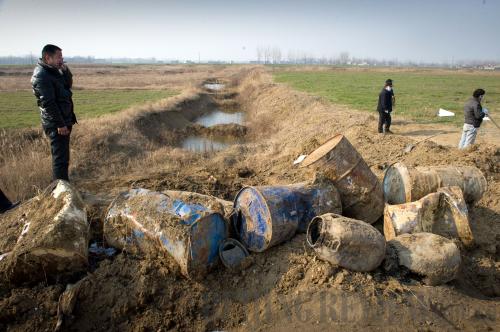|
 |
|
SPOILING THE SOIL: Containers filled with dangerous chemicals are abandoned without treatment in Lixin County, east China's Anhui Province, on January 7 (GUO CHEN) |
Despite having bought a new house in Wuhan in central China's Hubei Province early in 2010, Zheng Hongyuan's family remains living in a rented house located elsewhere. Like many other frustrated people who bought property in the area, Zheng lives in fear of what lies in the ground below it.
In October 2010, Zheng got the key to his new house in an affordable housing project. The compound, with 2,400 apartments, was built to meet the demand of middle- and low-income earners. Those who were eligible to purchase the property were considered lucky.
But just as he had finished sprucing up the place and was about to move in, Zheng received news that destroyed his dreams. He learned that the new house was located on a "brownfield site," which means that the land had previously been used for industrial or commercial purposes that had very likely left the area contaminated by hazardous waste or pollution.
Zheng later found that the plot of land had been subjected to contamination for more than 60 years, first by a pharmaceutical factory and later a chemical plant.
In 1997, after the chemical plant was closed down, a factory for manufacturing electroplating additives moved in, exposing the land to further pollution, which included numerous fluorine products.
However, during the construction of the affordable housing project where Zheng would live, the developer did not evaluate the site's health risks at all, according to a report by The Beijing News.
It was not until construction was almost finished in 2009 that an environmental review by the Wuhan-based China University of Geosciences discovered that the site was contaminated with antimony, a metallic element that can cause heart and lung problems, as well as with organic pollutants.
As a remedy, plastic sheeting was spread over 21,000 square meters to insulate the contaminated soil, and new soil was spread on top of the plastic. The measures cost the developer 6.8 million yuan ($1.08 million).
Local officials said the compound is now safe to live in, but some residents aren't so sure. There are still 3,200 tons of contaminated soil buried beneath them, according to The Beijing News.
"Living in houses built on such land can affect human health in many ways. We have seen several tragedies caused by brownfield sites worldwide," said Gao Shengda, Editor in Chief of hjxf.net, a website focuses on environmental protection in China.
Brownfield sites are increasing in major Chinese cities as urban sprawl has overrun many polluting factories, pushing them to new locations and leaving health risks behind.
In Beijing, more than 100 polluting factories inside the 4th Ring Road have been relocated, leaving as much as 8 million square meters of industrial land to be redeveloped. Shanghai, Chongqing, Guangzhou in southern Guangdong Province and other big cities are in a similar situation.
| 